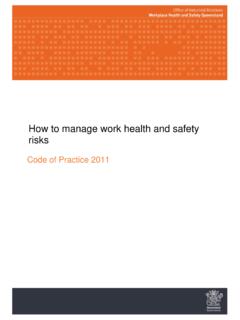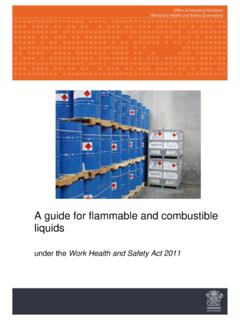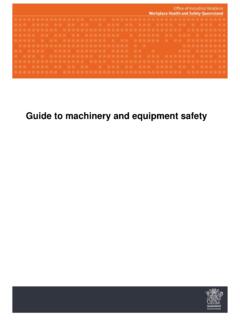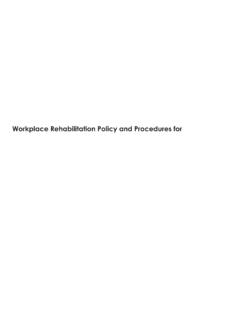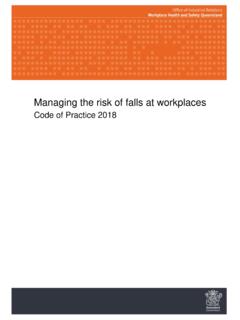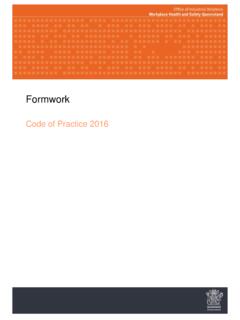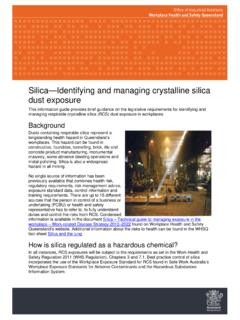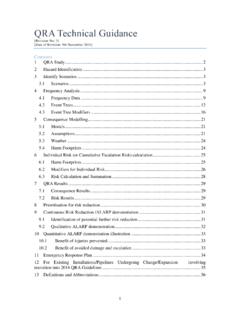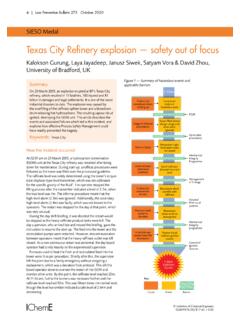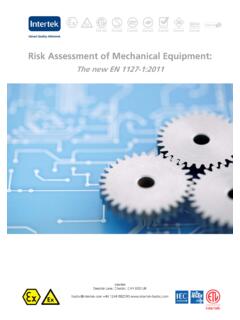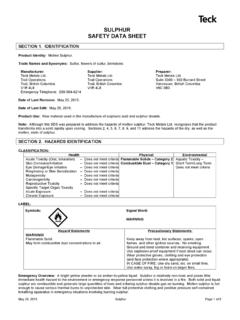Transcription of Emergency planning for ammonia-based refrigeration systems ...
1 Emergency planning for ammonia-based refrigeration systems guide PN10942 Version 2 Last updated February 2018 - Emergency planning for ammonia-based refrigeration systems guide Page 2 of 19 The State of Queensland 2018 Copyright protects this document. The State of Queensland has no objection to this material being reproduced, but asserts its right to be recognised as author of the original material and the right to have the material unaltered. The material presented in this publication is distributed by the Queensland Government as an information source only. The State of Queensland makes no statements, representations, or warranties about the accuracy or completeness of the information contained in this publication, and the reader should not rely on it. The Queensland Government disclaims all responsibility and all liability (including, without limitation, liability in negligence) for all expenses, losses, damages and costs you might incur as a result of the information being inaccurate or incomplete in any way, and for any reason.
2 PN10942 Version 2 Last updated February 2018 - Emergency planning for ammonia-based refrigeration systems guide Page 3 of 19 Table of contents Introduction .. 4 Definitions .. 4 What is anhydrous ammonia and why is it so dangerous? .. 5 What are the health effects? .. 5 What are the hazards from ammonia released into the air? .. 5 Safety duties .. 6 Who has safety duties? .. 6 Emergency plans .. 8 Why do we need Emergency plans? .. 8 How to develop an Emergency 8 What to include in the Emergency plan .. 9 How to document the Emergency plan .. 9 Emergency planning for anhydrous ammonia .. 9 Potential emergencies .. 9 Organisational structure including roles and responsibilities .. 11 Resources and equipment .. 12 Emergency procedures .. 14 Environmental considerations .. 17 Layout of workplace .. 18 Emergency contact details .. 18 Training .. 18 Testing and reviewing the Emergency plan .. 19 PN10942 Version 2 Last updated February 2018 - Emergency planning for ammonia-based refrigeration systems guide Page 4 of 19 Introduction Under the Work Health and Safety Act 2011 (WHS Act), all workplaces must prepare an effective Emergency plan for the workplace.
3 The Emergency plan must take into account the: nature of the work being carried out nature of the hazards at the workplace size and location of the workplace number and composition of the workers and other persons at the workplace. Workplaces with ammonia-based industrial refrigeration systems must plan for emergencies involving this type of system. Such emergencies involve the release of a toxic ammonia gas that can place workers and others health and safety at risk. An Emergency plan is a written document detailing how a workplace and its occupants deal with and manage an Emergency such as an ammonia gas release. The level of detail in the Emergency plan will depend on the complexity of the facility, the extent of its operations and workforce, and how much and what type of material is being stored and handled. This guide provides information to assist a person conducting a business or undertaking (PCBU) to prepare an effective Emergency plan for workplaces with anhydrous ammonia-based refrigeration systems .
4 The guide includes information on the unique hazards presented by ammonia gas and its use in refrigeration , and relevant duties that apply under the work health and safety (WHS) legislation. It should be read in conjunction with Emergency planning : Guidelines for Hazardous Industry1, which addresses Emergency planning for hazardous materials in general. Definitions Emergency A sudden unexpected event that requires action to correct and protect lives, or property, and the environment. It may include fire, explosion or toxic material release, an electrical failure, security breach or a natural event. Emergency planning Preparing to manage an Emergency that aims to prepare for and mitigate the effects of the Emergency . Emergency plan A written document detailing how a workplace and its occupants manage Emergency events that may occur. The plan consists of: preparedness, response and recovery activities agreed Emergency management roles, responsibilities, strategies and system arrangements for the workplace.
5 Ammonia References to ammonia in this document may cover the various phases of anhydrous ammonia including gas, vapour , liquid and aerosol. If a particular phase is relevant, it will be specifically identified. 1 Emergency planning - Guidelines for Hazardous Industry, a joint publication by the Australian and New Zealand Hazardous Industry planning Taskforce and Chemical Hazards and Emergency Management Unit, 1998 available at PN10942 Version 2 Last updated February 2018 - Emergency planning for ammonia-based refrigeration systems guide Page 5 of 19 What is anhydrous ammonia and why is it so dangerous? Anhydrous ammonia, at room temperature, is a pungent, colourless and highly water-soluble gas that can be liquefied under pressure or by cooling to below its boiling point ( ) at atmospheric pressure. Anhydrous ammonia (where anhydrous means without water ) has a high affinity for water and is highly water soluble.
6 When anhydrous ammonia is dissolved in water, it forms an alkaline solution of ammonium hydroxide leading to higher pH levels in the solution. Alkaline pH levels create the corrosive conditions that can cause extensive damage to moist areas, including the skin, and the mucous membranes of the eyes, nose, mouth and throat. What are the health effects? Exposure to anhydrous ammonia can have the following health effects2: up to 100 parts per million (ppm) no adverse effect for the average worker with no deliberate exposure for long periods permitted 400 ppm immediate nose and throat irritation with no serious effect after 30 minutes to one hour 700 ppm immediate eye irritation with no serious effect after 30 minutes to one hour 1,700 ppm convulsive coughing; severe eye, nose and throat irritation; could be fatal after 30 minutes 2,000-5,000 ppm convulsive coughing, severe eye, nose, and throat irritation; could be fatal after 15 minutes over 5,000 ppm respiratory spasm, rapid asphyxia and fatal within minutes.
7 Anhydrous ammonia destroys delicate respiratory tissue in the lungs causing pulmonary and respiratory distress. The effect on the eye depends on whether a spray or gas is involved, and may range from mild irritation to eye destruction. Severe ammonia inhalation injury can be followed by a persistent asthma-like syndrome and airway hyper-responsiveness3. Moist and sweaty skin is prone to ammonia chemical burns. As an alkali, ammonia causes tissues to liquefy where anhydrous ammonia burns keep spreading until the chemical is diluted. As well as liquefaction, supercooled anhydrous ammonia spray causes a freeze-dry effect like frostbite when it hits skin and is also capable of freezing clothing to skin. What are the hazards from ammonia released into the air? Liquefied ammonia released during an incident presents other hazards. For example, liquefied ammonia has an expansion ratio of approximately 850 to 1, which means that on release to ambient air, a given volume of liquefied ammonia will expand 850 times and could potentially cover an extensive area.
8 Such a release will also involve an aerosol phase ( small liquid droplets) along with ammonia gas. When released, it will be very cold and consequently behave as a dense gas (even though it is normally lighter than air) until it is warmed. One of the main characteristics of this cold dense gas behaviour is that the vertical mixing is suppressed. This is due to a stable density layering effect, which generates a slowly diluting vapour cloud that hugs the ground. A release that travels along the ground rather than immediately rising into the air increases the risk of exposure to workers and others. Released ammonia will rapidly absorb moisture from air and will form a dense, visible white cloud at high concentrations. This effect is graphically displayed in a series of images included in Figure 1. These images were from CCTV footage of an anhydrous ammonia gas release caused by a ruptured hose during a transfer of the product between a storage tank and a tanker vehicle.
9 The release occurred in Seward, Illinois in 2007 and was reported as being up to 18,000 kilograms4. 2 AS2022 (2003) The storage and handling of anhydrous ammonia, Standards Australia, 3 Clinical Environmental Health and Toxic Exposures, Editors J B Sullivan Jr, G R Krieger, 2nd Edition, 1999. 4 Images collected from Youtube clip available at The extent of damage to human tissue will depend on the concentration and length of time of exposure to anhydrous ammonia. PN10942 Version 2 Last updated February 2018 - Emergency planning for ammonia-based refrigeration systems guide Page 6 of 19 Figure 1: Series of photos showing an ammonia gas cloud travelling from the release point keeping low and travelling along the ground. If there is no visible cloud , an ammonia release can be detected by its pungent odour at low concentrations. The odour threshold for ammonia is reported in the range ppm.
10 Ammonia may be a fire and explosion hazard at concentrations between 15 and 25 per cent in air. If the airborne concentration of ammonia is within the flammable range (typically under confinement), it can be ignited by something as common as an electric spark from a switch. Ammonia has a minimum ignition energy of 680 millijoules (mJ5) and an auto-ignition temperature of 669oC6. Safety duties Who has safety duties? A PCBU ( the person who has overall responsibility for the workplace with an ammonia-based refrigeration system) has duties under the WHS Act for implementing safe systems of work including conducting a comprehensive hazard identification and risk assessment of the workplace to identify situations that will require planning for an Emergency . The process must look at the hazards presented by: anhydrous ammonia and the various phases, including liquid and aerosol phases associated plant and equipment, including storage and handling systems related activities such as operation, maintenance, repair and decommissioning.
